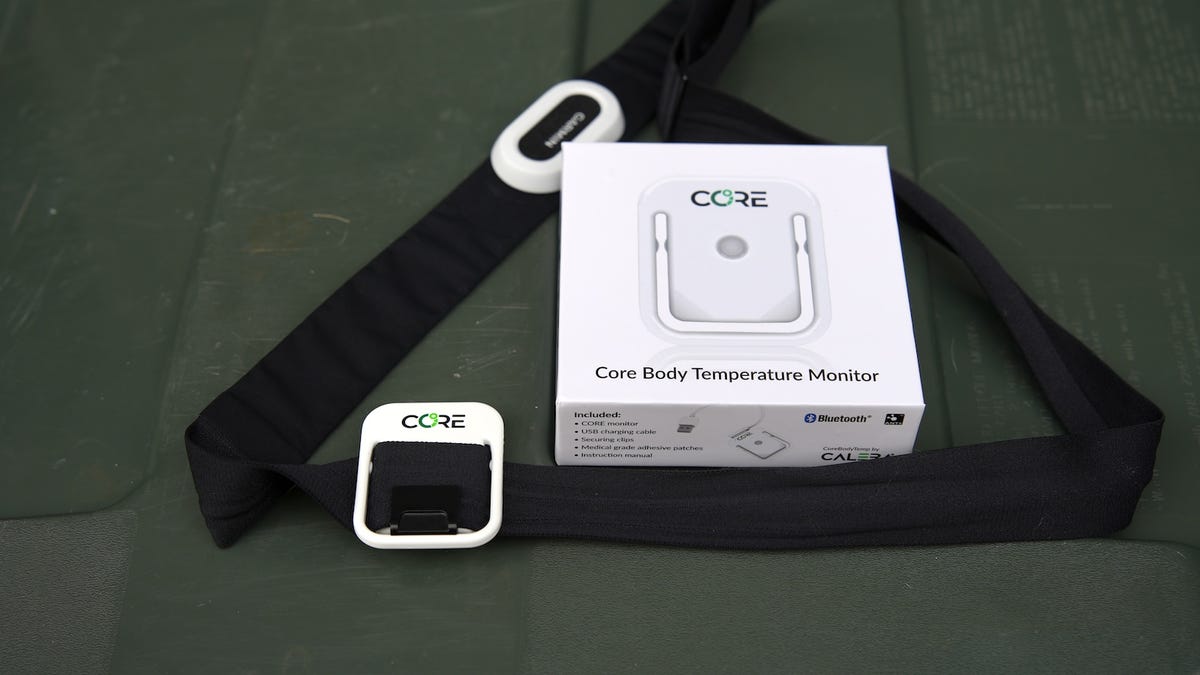ZDNET’s key takeaways
- The Core body sensor is available now for $285.
- It provides an accurate internal body temperature, is lightweight, has a long battery life, and is a functional smartphone app.
- The device is rather expensive and needs to be connected to a chest strap or adhesive patch.
Wearable technology has advanced significantly over the last decade, and amateur athletes today can capture an extensive amount of data with their smartwatches, GPS sports watches, and external heart rate monitors. For the past couple of months I have been running and cycling with the Core sensor, a wearable device that captures and records your internal body temperature without the need for any more invasive methods.
Also: Best sports watches
Heart rate tracking has historically been the most common metric in performance tracking for runners, but over the last couple of years more eyes have been looking at running power. Most every new GPS sports watch and smartwatch now captures and calculates running power in attempt to normalize the uneven terrain you may be training on and how much physical effort you’re outputting.
The Core body temperature sensor adds another element to your training regime, and while it may be more important for professional athletes, it is priced where even amateur athletes can gain access to its insights. When I first tested it in January in the Pacific Northwest, the outside temperatures were too cold for me to measure any noticeable increase in my internal body temperature.
Also: My favorite bone conduction headphones for swimming just got a major audio upgrade
However, after taking a trip to visit my daughter and future son-in-law in Australia, I saw first-hand the value of the Core’s metrics. I went on three long runs during my first week in temperatures that you’d only see at the height of summer in Washington state and was surprised to see my core temperature and heat strain index numbers increase to a level where the device indicated my performance would start to suffer.
With my recent 20-pound weight loss, my running pace has increased significantly and given the mostly flat landscape in Brisbane, I was able to track my speed easily. After 35 to 40 minutes, though, my pace decreased while my sweat level increased. I slowed down a bit and saw my internal temperature decrease as well.
Australia is much more humid and hot than Washington State, but as I have grown older my tolerance for humidity has increased, so I was quite comfortable running in the humid conditions. While running in Washington, my skin temperature feels quite cold, even after a long run with lots of sweat. Conversely, my skin temperature remained much more constant in Australia.
This points to one of the main uses of the Core body sensor used by athletes: to identify optimal cooling strategies during tough training sessions. Core’s website shares experiences with cyclists recognizing up to an 8% increase in speeds after just 10 days of heat-focused training. Unfortunately, I did not train long enough with the Core to build a training strategy with it, but I was able to capture enough data to see the potential benefits of training with the sensor.
One of the easiest ways to attach the Core for tracking your temperature is to attach it to a heart rate chest strap, and I ran with it connected to the strap on my Garmin HRM-Pro Plus. The clip locks the Core into place really well, but you can also use the included single-use sports adhesive patches to attach the Core sensor directly to your body.
When it comes to powering the device, the Core sensor charges via the USB-A cable with its proprietary magnetic cable. Core advertises six days of continuous use with a full charge, and in my eight training sessions with the device, I only charged it up once to ensure it was ready to go for all of my longer runs.
Also: The best smartwatches of 2024: Expert tested and reviewed
The Core measures your skin temperature and then uses its proprietary algorithms to calculate your internal body temperature. Testing has validated the accuracy of the Core sensor so there is no need to use an internal probe or e-pill to measure your internal temperature. Since I have not used a rectal probe since I was a child, it was interesting to see the measurements of my internal temperature.
While there is a Core smartphone application that collects and shows all of your measurement data, you can also connect the Core sensor to your Garmin, Coros, Suunto, Apple Watch, and other current wearables. I primarily used it with a Garmin Quatix 7 Pro and Coros Apex 2 Pro so it was great to have the Core data appear as a separate field while running and then in the summary data pages in the associated smartphone applications.
The highest body temperature I measured during my five workouts in Washington was 100.9 degrees. In Australia, I saw a high of 102.5 degrees in my last of three runs. That run was just over seven miles in length and ended near 10 am so the outside temperature was rising.
Also: The best fitness rings you can buy: Expert tested
My heat strain index also rose to 4.12 during this run and it was clear if I ran longer that I needed to slow down and reduce my internal temperature. Knowing these heat load and workout load metrics provided by the device can go a long way to optimizing a training regime and gaining insight into your body’s own physical limits.
If you are considering the Core body sensor to help you train better, I highly recommend that you read through the manual and FAQs posted on its website. There are also testimonials from athletes that may help you figure out if the $285 sensor is worth it for better understanding your body and how it reacts to the environment and your training regime. Core states that internal temperatures above 102 degrees Fahrenheit start to put the human body at risk of heat stress.
ZDNET’s buying advice
While I could train for my simple recreational races and activities without the use of wearable technology, I find capturing the data and then running reports to be fascinating. The Core body sensor adds another metric to the mix and if I lived in regions like Australia or the southern US then I would consider adding the sensor to my arsenal. It is fascinating to see how accurate the Core sensor is and using it is more affordable than advanced body temperature methods traditionally used by high-performance athletes.







